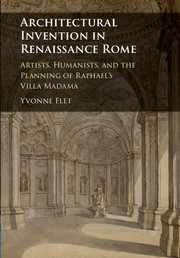 Architectural Invention in Renaissance Rome
Architectural Invention in Renaissance Rome Book contents
- Frontmatter
- Dedication
- Contents
- List of Plates
- List of Figures
- Preface and Acknowledgments
- Note on Translations and Abbreviations
- Introduction: The Nature of Invention, in Word and Image
- 1 Reviving the Corpse
- 2 Writing Architecture
- 3 Sperulo's Vision
- 4 Encomia of the Unbuilt
- 5 Metastructures of Word and Image
- 6 Dynamic Design
- Conclusion: Building With Mortar and Verse
- APPENDIX I Francesco Sperulo, Villa Iulia Medica versibus fabricata/ The Villa Giulia Medicea Constructed in Verse: critical edition and translation by Nicoletta Marcelli and gloss by the Author
- APPENDIX II Francesco Sperulo, Villa Iulia Medica versibus fabricata: Analysis of the presentation manuscript
- APPENDIX III Francesco Sperulo, Ad Leonem X de sua clementia elegia xviiii
- Notes
- Bibliography
- Index
6 - Dynamic Design
Published online by Cambridge University Press: 06 January 2018
- Frontmatter
- Dedication
- Contents
- List of Plates
- List of Figures
- Preface and Acknowledgments
- Note on Translations and Abbreviations
- Introduction: The Nature of Invention, in Word and Image
- 1 Reviving the Corpse
- 2 Writing Architecture
- 3 Sperulo's Vision
- 4 Encomia of the Unbuilt
- 5 Metastructures of Word and Image
- 6 Dynamic Design
- Conclusion: Building With Mortar and Verse
- APPENDIX I Francesco Sperulo, Villa Iulia Medica versibus fabricata/ The Villa Giulia Medicea Constructed in Verse: critical edition and translation by Nicoletta Marcelli and gloss by the Author
- APPENDIX II Francesco Sperulo, Villa Iulia Medica versibus fabricata: Analysis of the presentation manuscript
- APPENDIX III Francesco Sperulo, Ad Leonem X de sua clementia elegia xviiii
- Notes
- Bibliography
- Index
Summary
FROM THE ANALYSIS OF POETRY AND PROSE TEXTS, GROUND plans, and antiquities, it emerges that the Medici villa was designed via an intense collaboration and cross-fertilization of ideas among architects and humanists. As we have seen, they conceived multivalent frameworks of word and image that could be realized in the villa complex at many stages of design and execution, from ground plans to decorations. It has long been recognized that Raphael was assisted in the villa project by Antonio da Sangallo the Younger, Giovan Francesco da Sangallo, Giulio Romano, and other talented artists and architects whose drawings document their presence in Raphael's workshop. Likewise, their engaged Medici patrons certainly provided ideas. This analysis of texts, notably Sperulo's poem, reveals the involvement of humanists, who contributed to functional as well as visual and spatial constructs, and did so surprisingly early in the planning process. This chapter reconsiders the roles of architect and so-called humanist advisor, who were engaged in what I characterize as an iterative, collaborative design process that extended over the long time period such a building project required. This scenario of creative collaboration is at odds with the concept of a building or even a poem as an autonomous work of art, which raises interesting questions of architectural authorship and the nature of invention in the early cinquecento, a pivotal time for the role of the architect.
RECONFIGURING THE ROLES OF ARTISTS AND ADVISORS
Collaboration was a hallmark of Raphael's working methods, as recent scholarship has recognized – a necessity given the staggering array of colossal projects he directed simultaneously; but there is a dearth of evidence about the specific nature of his interactions with collaborators, within the workshop and beyond. He had an extraordinary ability to attract and develop brilliant artists, and he seemed comfortable giving some of them an unusual degree of creative control, most famously his right-hand assistant Giulio Romano. Raphael's Louvre self-portrait with another man, perhaps Giulio, seems to illustrate the nature of this dynamic with his younger associates (Figure 79).
- Type
- Chapter
- Information
- Architectural Invention in Renaissance RomeArtists, Humanists, and the Planning of Raphael's Villa Madama, pp. 142 - 169Publisher: Cambridge University PressPrint publication year: 2018


